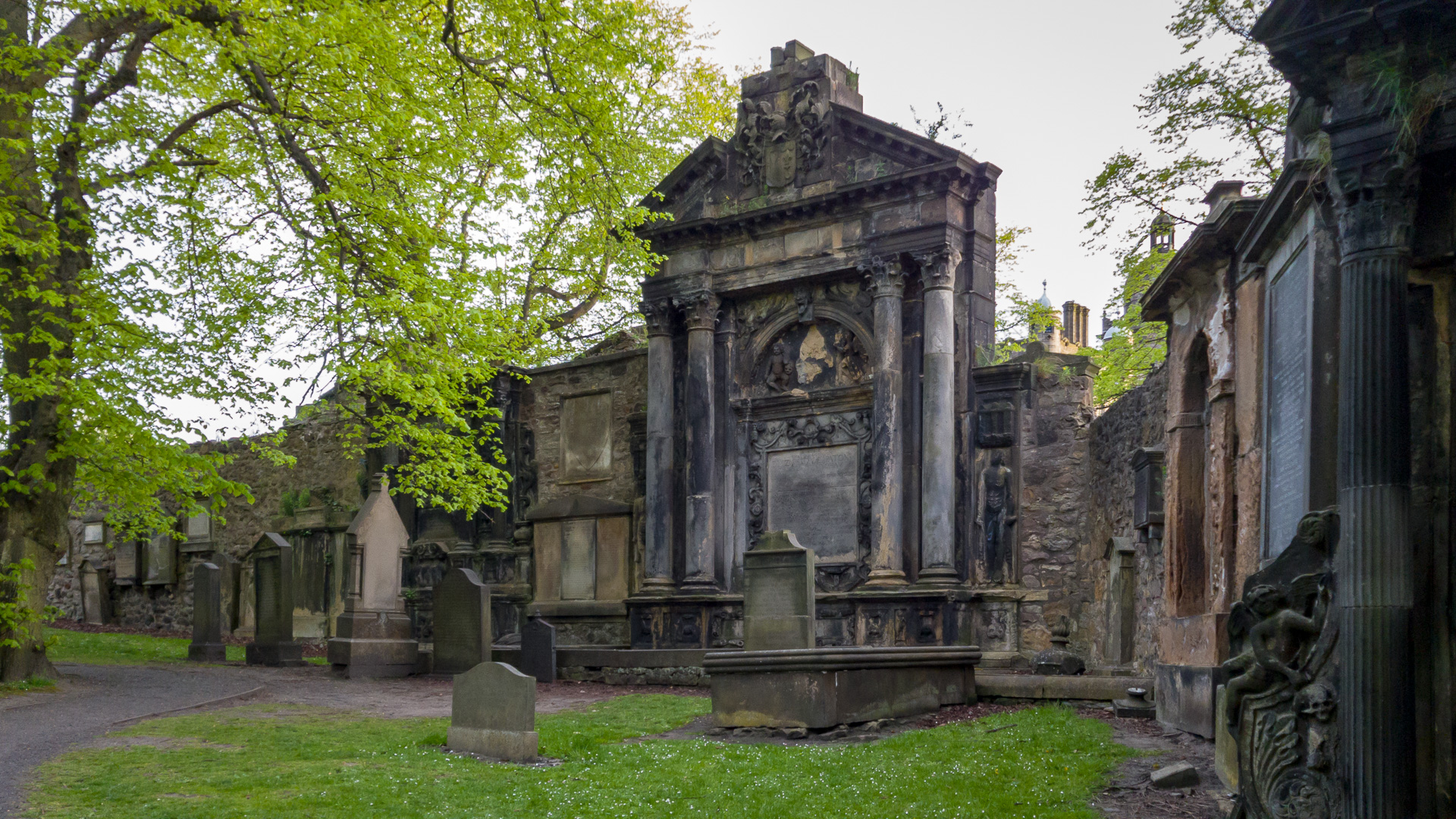The eerily beautiful Greyfriars Kirkyard is located in the centre of Edinburgh. It is surrounded by legends and true stories in equal measure. A visit.

It’s only a few steps from the lively Grassmarket square with all its pubs and shops to the quiet realm of the dead. A green meadow dotted with old grey stones, shaded by large trees and surrounded by high walls, against which tombstones lean, framed by columns and ornaments. In the centre rises majestically the great Greyfriars Kirk. Welcome to the Greyfriars Kirkyard in Edinburgh.
For almost 500 years, Edinburgh residents have been laid to rest here. But it wasn’t the dead that made Greyfriars Kirkyard a place that had a profound impact on Scotland’s history.
The church in the graveyard was not completed until 1620. But just 18 years later, Scottish church representatives signed the National Covenant here, in which they opposed the king and his attempt to impose the English church liturgy on them. This act certainly harboured a hint of democratic ideas, which the king could not tolerate. Not only, but also because of this, Britain sank into decades of conflict.
The irony of history is sometimes bitter. For when the final battle between the government and the Covenanters took place at Bothwell Bridge in 1679, the Covenanters quickly lost. Over a thousand were taken prisoner. But what to do with these prisoners? They had to be housed somewhere until it was decided what to do with them.
They were taken to Edinburgh, where they were held in Greyfriars Kirkyard of all places – the gate labelled “Covenanters Prison” is still a reminder of this today.
Behind the gate, visitors can now only see a small part of the square that used to exist here. Houses were built here over the next few centuries.
Incidentally, most of the prisoners were released after swearing allegiance to the king. Only a few were deported overseas or even executed. Perhaps it is their souls that make Greyfriars Kirkyard one of the most haunted places in the world.
The spooky flair of the cemetery has also attracted another visitor who found particular inspiration in a gravestone. Harry Potter’s antagonist. One of the graves bears a special inscription: “Sacred to the Memory of Thomas Riddel Esq. of Befsborough”. Harry Potter fans are likely to prick up their ears at the name. After all, Tom Riddle was the name of the young man who later became the dreaded Lord Voldemort. And so today, many visitors make a pilgrimage straight to this gravestone.
Harry Potter creator J.K. Rowling has said that she often walked in the cemetery and perhaps picked up the name unconsciously. The poor man who lies here has nothing to do with the one “whose name you are not allowed to pronounce”. After all, he was 72 years old. There are other names in the cemetery that appeared in the stories, such as William McGonagall or a Mr Moody.
And one story must not remain untold. That of Greyfriars Bobby, the little Skye terrier, who allegedly did not leave his master’s side even after his death and lived in the graveyard. He moved the people of Edinburgh so much that they erected a bronze statue in his memory, which stands outside the pub of the same name.
Historians doubt the story of the Greyfriar’s Bobby. They assume that it was several dogs belonging to the graveyard keeper, who was already attracting tourists with this story.
Whether dog or not, ghost or not, Harry Potter fan or not – a visit to Greyfriars Kirkyard in the centre of Edinburgh is simply worth it for its mausoleums and gravestones.
What you need to know: Where the name Greyfriars Kirkyard comes from
Originally, the Franciscans worked here and the name “Greyfriars” comes from their grey robes. But after the Reformation, the Catholic monks had to leave and the land fell to Mary Queen of Scots, who had a cemetery made for the growing Edinburgh.
Incidentally, there is also the area of the Blackfriars in Edinburgh. The inhabitants of Edinburgh referred to the monks of the Jesuit order as the “black friars”.
Personal note: A cemetery with gardens inside
What I really like are the many small garden areas that turn the cemetery into a small park. Apart from the old trees, there are also herb and flower beds.
Approach:
The two entrances to Greyfriars Kirkyard are both off Candlemaker Row. To the east of the Grassmarket, on the same side as West Wall Well and Victoria Street, there is a roundabout at Cowgatehead. This is where Candlemaker Road starts and right at the beginning there are some steps leading up to the cemetery.
The other entrance is further up the same road. It is worth visiting if you are coming from the National Museum. The statue of Greyfriars Bobby is also located here.